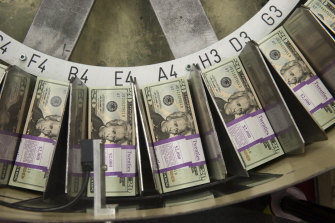It’s the supply chain issues, the war and a weak currency – until this week the euro was at five-year lows against a US dollar that has been strengthening markedly in response to the Fed’s sudden adoption of tighter monetary policies – that are driving the inflation rate.
Lagarde singled out “imported” inflation, describing it as a “terms of trade tax.” Over the last year, she said, the euro area had transferred €170 billion ($257 billion), or 1.3 per cent of its GDP, to the rest of the world via the net cost (after accounting for more competitive exports) of higher import prices.

The Greek economy looks especially vulnerable to rising interest rates. Credit:Bloomberg
The ECB’s shift from policies that have seen its balance sheet explode from about €1.5 trillion in 2007 to about €8.8 trillion today will add to the global monetary tightening that is already wreaking havoc in investment markets. The Fed’s balance sheet swelled from less than $US1 trillion ($1.4 trillion) to about $US9 trillion over the same period.
The ECB’s proposed actions will, however, help weaken a US dollar that was appreciating rapidly and not just against the euro.
That could provide some relief for emerging market economies and even China, which were experiencing capital outflows and higher borrowing costs and debt repayments on US dollar-denominated debts as the dollar strengthened.
Loading
The dollar had appreciated about 8 per cent against the basket of its major trading partners’ currencies this year and provoked talk of a new Plaza Accord (a 1985 agreement by the G-5 economies to force the value of the then-soaring dollar down) before Lagarde’s blog post.
The dramatic shift in the ECB’s policies, assuming they do eventuate, isn’t without risk.
The pandemic has wrought considerable damage to some European economies that had very weak finances even before COVID hit. Over-leveraged economies have added even more debt even as their condition deteriorated.
The post-financial crisis stresses that nearly blew the eurozone apart was centred in southern Europe (remember “Grexit” and “Quitaly”) and they will feel the brunt of higher interest rates more than Germany or France with their stronger economic fundamentals.
Greece has a debt-to-GDP ratio of about 185 per cent. Italy’s is about 150 per cent, with a budget deficit of about 10 per cent of GDP. Portugal’s debt-to-GDP ratio is 122 per cent and Spain’s close to 120 per cent.
The potential for a new sovereign debt crisis in the eurozone is real.

The ECB’s proposed actions will help weaken a US dollar that was appreciating rapidly and not just against the euro.Credit:Getty
Southern Europe, and Italy and Greece in particular, have been kept afloat by the negative interest rates and ECB bond-buying. The ECB has soaked up almost all of Italy’s debt issuance.
The end of quantitative easing and higher rates, albeit still at negligible levels, will put the squeeze on the southern European economies and impose new pressures on the cohesiveness of the European Project and a bloc that nearly fractured in the aftermath of the financial crisis because of the disparate conditions of its individual economies.
If the ECB follows through on Lagarde’s comments it will finally end the novel period of monetary policy.
The ECB’s negative rate – its key rate today is minus 0.5 per cent — was designed to try to coerce European lenders to lend rather than pay to lodge their surplus cash with the central bank and other financial institutions to accept more risk in pursuit of positive returns.
The post-financial crisis stresses that nearly blew the eurozone apart was centred in southern Europe and they will feel the brunt of higher interest rates more than Germany or France with their stronger economic fundamentals.
The ECB would argue that the policy was successful, although it squeezed already modest European banks’ profitability, undermined the solvency of pension funds and produced perverse outcomes by encouraging a flood of cash into negative-yielding assets as investors feared rates night go further into negative territory. There were even corporate “borrowers” who were able to raise debt at negative coupons – they were paid to borrow!
That wasn’t completely peculiar to Europe. At their peak in 2020 there were close to $US19 trillion of corporate and government debt instruments with negative yields. Today there’s virtually none.
If the Fed and ECB and others (like our Reserve Bank) can back out of the unconventional monetary policies that the two big central banks have pursued for most of the past 14 years without blowing up economies and markets in the process (or at least not completely melting down markets) it would be a major milepost in the progress from the financial crisis towards more historically normal settings.
Loading
That “if,” however, looms large for Italy and others in southern Europe, for China and emerging market economies and investors in everything from shares to crypto assets, to bonds – as does a successful transition and the dramatic tightening of global financial conditions and higher cost of credit that would imply. It’s a brave and risky new world.
The Business Briefing newsletter delivers major stories, exclusive coverage and expert opinion. Sign up to get it every weekday morning.
Stay connected with us on social media platform for instant update click here to join our Twitter, & Facebook
We are now on Telegram. Click here to join our channel (@TechiUpdate) and stay updated with the latest Technology headlines.
For all the latest Business News Click Here
For the latest news and updates, follow us on Google News.
